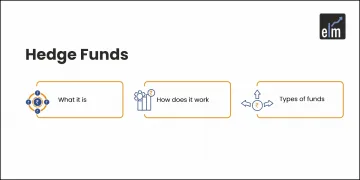In today’s volatile market, it is very important to hedge your portfolio using hedging strategies. To safeguard your portfolio from market volatility or uncertainty, you might hedge your portfolio by simultaneously opening multiple positions. This entails balancing profits from one position against losses from another.
Financial hedging often aims to hold a position on two different financial products that have a diametrically opposed connection to one another.
This implies that if the value of one instrument falls, it is likely that the value of the other will rise. This can help to offset any risk from the falling position with a profit. These investment selections need to be carefully considered and need not be made in a hurry.
Given that market volatility typically only lasts for brief periods of time and that short-term and medium-term traders seek to profit from sharp price movements, financial hedging may be more prevalent among these traders. Long-term position traders are more likely to open positions based on their projections for the long-term future than they are to consider current movements in the market.
In today’s blog let us discuss some hedging strategies that will help you to limit your losses and protect your portfolio when trading in the stock market:
Table of Contents
Why do Traders Hedge their Portfolio?
Retail traders that are proficient in the financial markets and have the ability to predict impending changes in the economy frequently employ hedging tactics. However, anyone can employ a hedging strategy, particularly if a sizable sum of money or a sizable portfolio is at stake. Because of this, experienced traders and institutional investors frequently employ this tactic.
Hedging is a risk-management tactic that aids in safeguarding your trading portfolio. Risks associated with trading in turbulent markets include fluctuations in interest rates and currency exchange rates, political, social, and economic instability, geographic shifts, and shortages of certain commodities, to mention a few.
All of these variables could be taken into account by a trader as part of their fundamental analysis prior to starting positions. In order to reduce losses, they are able to arrange their hedging tactics in advance of the markets in this way.
What are the Hedging Strategies?
Below are some of the hedging strategies which traders can use:

1. Forward Contracts
Hedgers may opt to employ a forward contract, which is an agreement to swap a financial asset at a predetermined price on a future date, when price swings in their preferred market are very turbulent.
You can do this to close out your position and receive payment before the delivery date. Since the terms of the contract are established at the outset of the transaction, hedgers frequently trade forwards to prevent the price volatility of an asset. Therefore, any price changes won’t have an impact on the price at the end of the forward contract.
A forward contract might be used, for instance, by a commodity trader worried about weather patterns or natural disasters that could affect the supply and demand for commodities like corn, wheat, or sugar. The traders will protect themselves against any risk factors that could result in losses by locking in the price from the beginning.
2. Futures and Options
Futures and option contracts are used in another sort of derivative trading. You may go long if your intention is to buy something in the future, but you could go short if your intention is to sell the asset.
Having future prices set in stone can help to lessen any ambiguity regarding market conditions. You would be required to complete the entire period of the contract for futures and options, which tend to be more regulated than forward transactions.
3. Safe Haven Assets
Due to its scarcity, dependability, and stability in the commodities market, gold, a member of the precious metals family, has frequently been referred to as a “safe haven” for many investors.
After many years, gold’s value has remained stable, and traders may decide to invest in gold as a strategy to protect their positions in other struggling markets during periods of political, social, and economic unpredictability.
Additionally, it aids in defending traders from market inflations and is frequently used as a hedge against both inflation and currency depreciation. When the stock market crashes, the price of gold likewise tends to rise, therefore stock traders may concentrate on this commodity during periods of rising downward volatility.
4. Pair Trading
Pairs trading is arguably the most popular hedging strategy. Pairs trading is best characterised as a long-short hedge technique since it is market-neutral. As long as there is a positive correlation between the two securities, it doesn’t matter if they are from the same asset class.
The trader should recognise when one asset is overvalued and one is undervalued in order to execute a pairs trading strategy, where their differing values are computed using the standard deviation.
Afterward, they can decide to initiate a buy position to go long on the asset that is undervalued and short sell the position that is overvalued. The assets must reverse to their initial positive correlation in order to turn a profit.
Get to know how gamma scalping can be used in options trading strategies.
5. Government Bonds
All year long, debt instruments like treasuries (T-bonds) and government bonds (gilts) are typically regarded as secure investments. They offer a fixed rate of return up until the bond’s maturity date, after which the government pays the bondholder the bond’s face value.
This implies that you will eventually receive your investment money back. Government bonds can still be impacted by interest rates, inflation, and currency strength for a specific economy, just less so than other financial markets like the stock market because they tend to draw less risk-tolerant investors. Government bonds are frequently regarded as a safe haven in times of market unpredictability.
Advantages of Hedging Portfolio
Below are some of the advantages of portfolio hedging:
- By hedging, one can reduce losses and lock in gains.
- The tactic can be applied to get through challenging market times.
- You are protected from a variety of fluctuations, including those brought on by inflation, interest rates, and foreign exchange rates.
- Your trading portfolio can be effectively diversified by including a variety of asset classes.
- increases the liquidity of the financial markets.
Disadvantages of Hedging Portfolio
Below are some of the disadvantages of portfolio hedging:
- Since no trading method is fully risk-free, you should still implement proper risk management measures, such as stop-loss orders and other controls, in your transactions.
- Hedging can, at best, only reduce losses because it rarely results in a trader making a profit.
Dive deeper into hedging strategies with our Option Trading Course. Enhance your financial market skills today!
Bottomline
Although investing in the stock market can be a terrific way to generate money, there are a number of hazards involved. Hedging methods can be useful for people who want to lower their risk exposure while benefiting from the possible rewards of investment.
Learn more about similar finance topics and enhance your skills through our equity research certification.
You can use StockEdge for market research
Frequently Asked Questions (FAQs)
What are the 3 common hedging strategies?
Diversification, option trading, and futures contracts are three prominent hedging techniques. Depending on your particular objectives and goals as an investor, each technique offers pros and cons.
What are the 3 common hedging strategies?
Diversification, option trading, and futures contracts are three prominent hedging techniques. Depending on your particular objectives and goals as an investor, each technique offers pros and cons.
What is a hedging strategy example?
For instance, if you purchase 100 shares of Stock A for Rs. 10 each, you may choose to protect your capital by purchasing a put option with a Rs. 8 strike price that expires in a year. You have the option to sell 100 shares of Stock A for Rs. 8 at any point during the following year.
What is the hedging strategy in business?
Although some sceptic company leaders see it as a type of risk-taking in and of itself, hedging is using various financial instruments to decrease the risk associated with price swings. However, hedging is frequently employed to achieve the reverse, to reduce risk, as we can see in our case.






